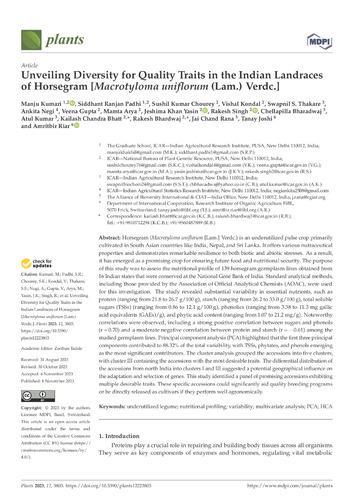Unveiling diversity for quality traits in the Indian landraces of Horsegram [Macrotyloma uniflorum (Lam.) Verdc.]
Horsegram (Macrotyloma uniflorum [Lam.] Verdc.) is an underutilized pulse crop primarily cultivated in South Asian countries like India, Nepal, and Sri Lanka. It offers various nutraceutical properties and demonstrates remarkable resilience to both biotic and abiotic stresses. As a result, it has emerged as a promising crop for ensuring future food and nutritional security. The purpose of this study was to assess the nutritional profile of 139 horsegram germplasm lines obtained from 16 Indian states that were conserved at the National Gene Bank of India. Standard analytical methods, including those provided by the Association of Official Analytical Chemists (AOAC), were used for this investigation. The study revealed substantial variability in essential nutrients, such as protein (ranging from 21.8 to 26.7 g/100 g), starch (ranging from 26.2 to 33.0 g/100 g), total soluble sugars (TSSs) (ranging from 0.86 to 12.1 g/100 g), phenolics (ranging from 3.38 to 11.3 mg gallic acid equivalents (GAEs)/g), and phytic acid content (ranging from 1.07 to 21.2 mg/g). Noteworthy correlations were observed, including a strong positive correlation between sugars and phenols (r = 0.70) and a moderate negative correlation between protein and starch (r = −0.61) among the studied germplasm lines. Principal component analysis (PCA) highlighted that the first three principal components contributed to 88.32% of the total variability, with TSSs, phytates, and phenols emerging as the most significant contributors. The cluster analysis grouped the accessions into five clusters, with cluster III containing the accessions with the most desirable traits. The differential distribution of the accessions from north India into clusters I and III suggested a potential geographical influence on the adaptation and selection of genes. This study identified a panel of promising accessions exhibiting multiple desirable traits. These specific accessions could significantly aid quality breeding programs or be directly released as cultivars if they perform well agronomically.

